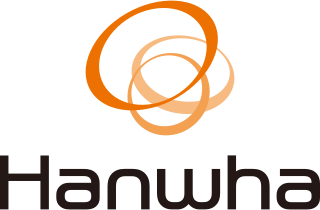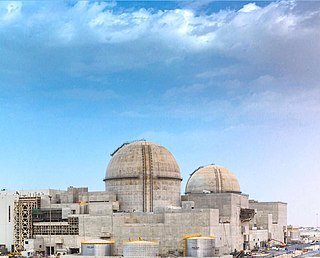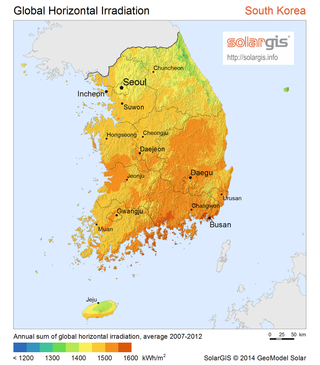List of hydroelectric power stations

Hydroelectric power accounted for 5% of South Korea's total installed power generation in 2021 and 0.33% of the total power generation. [1]


Tidal power or tidal energy is harnessed by converting energy from tides into useful forms of power, mainly electricity using various methods.

SK Group is a South Korean multinational manufacturing and services conglomerate headquartered in Seoul. A chaebol, SK Group is second largest such conglomerate by revenue in South Korea, after Samsung Group. Through a number of subsidiaries, it is engaged in various businesses, including manufacture of chemicals and petrochemicals, semiconductors, flash memory and miscellaneous information technology, as well providing telecommunications services worldwide among its other less notable ventures.
Korea Hydro & Nuclear Power is a subsidiary of the Korea Electric Power Corporation (KEPCO). It operates large nuclear and hydroelectric plants in South Korea, which are responsible for about 27 percent of the country's electric power.
KOMPSAT-1, also known as Arirang-1, was a satellite created by the Korea Aerospace Industries (KAI) and Korea Aerospace Research Institute (KARI), and launched by a United States launch vehicle on 21 December 1999. This was the first satellite built primarily by South Korean engineers, although previous foreign-built satellites had been launched by Korean companies. It took its name from the popular Korean folk song Arirang.
Korea Electric Power Corporation, better known as KEPCO or Hanjeon, is the largest electric utility in South Korea, responsible for the generation, transmission and distribution of electricity and the development of electric power projects including those in nuclear power, wind power and coal. KEPCO, through its subsidiaries, is responsible for 93% of Korea's electricity generation as of 2011. The South Korean government owns a 51.11% share of KEPCO. Together with its affiliates and subsidiaries, KEPCO has an installed capacity of 65,383 MW. On the 2011 Fortune Global 500 ranking of the world's largest companies, KEPCO was ranked 271. KEPCO is a member of the World Energy Council, the World Nuclear Association and the World Association of Nuclear Operators. As of August 2011, KEPCO possesses an A+ credit rating with Fitch Ratings, while Moody's has assigned KEPCO an A1 stable rating.
Nuclear power is a major power source in South Korea, providing 29% of the country's electricity. The total electrical generation capacity of the nuclear power plants of South Korea is 20.5 GWe from 23 reactors, equivalent to 22% of South Korea's total electrical generation capacity.
For solar power, South Asia has the ideal combination of both high solar insolation and a high density of potential customers.
Nuclear power is the fifth-largest source of electricity in India after coal, gas, hydroelectricity and wind power. As of November 2020, India has 22 nuclear reactors in operation in 8 nuclear power plants, with a total installed capacity of 7,380 MW. Nuclear power produced a total of 43 TWh in 2020–21, contributing 3.11% of total power generation in India. 10 more reactors are under construction with a combined generation capacity of 8,000 MW.

Solar power, also known as solar electricity, is the conversion of energy from sunlight into electricity, either directly using photovoltaics (PV) or indirectly using concentrated solar power. Solar panels use the photovoltaic effect to convert light into an electric current. Concentrated solar power systems use lenses or mirrors and solar tracking systems to focus a large area of sunlight to a hot spot, often to drive a steam turbine.

South Korea is a major energy importer, importing nearly all of its oil needs and ranking as the second-largest importer of liquefied natural gas in the world. Electricity generation in the country mainly comes from conventional thermal power, which accounts for more than two thirds of production, and from nuclear power.

Sihwa Lake Tidal Power Station is the world's largest tidal power installation, with a total power output capacity of 254 MW. When completed in 2011, it surpassed the 240 MW Rance Tidal Power Station, which was the world's largest for 45 years. It is operated by the Korea Water Resources Corporation.

The Hanul Nuclear Power Plant is a large nuclear power station in the Gyeongsangbuk-do province of South Korea. The facility has six pressurized water reactors (PWRs) with a total installed capacity of 5,881 MW. The first went online in 1988. In the early 2000s it was the third largest operational nuclear power plant in the world and the second largest in South Korea. The plant's name was changed from Uljin to Hanul in 2013.

Russia is the fourth largest generator and consumer of electricity in the world. Its 440 power stations have a combined installed generation capacity of 220 GW.
Vietnam is considering developing nuclear power for peaceful purposes based on modern, verified technology since 1995, and firm proposals surfaced in 2006. In November 2016 Vietnam suspended its nuclear power plans. In 2022 industry and trade minister Nguyen Hong Dien announced that developing nuclear power is an “inevitable trend” for Vietnam, and will help the country to become carbon neutral by 2050.

Hanwha Group is a large business conglomerate (chaebol) in South Korea. Founded in 1952 as Korea Explosives Co., the group has grown into a large multi-profile business conglomerate, with diversified holdings stretching from explosives—their original business—to energy, materials, aerospace, mechatronics, finance, retail, and lifestyle services. In 1992, the company adopted its abbreviation as its new name: "Hanwha".
POSCO Energy is the largest private energy producer in South Korea. It is a member of the POSCO consortium, and was established on November, 1969, in South Korea as the nation's first private electricity supplier. The main businesses are in coal-fired power generation, fuel cells, liquid natural gas (LNG), and off-gas power.

The APR-1400 is an advanced pressurized water nuclear reactor designed by the Korea Electric Power Corporation (KEPCO). Originally known as the Korean Next Generation Reactor (KNGR), this Generation III reactor was developed from the earlier OPR-1000 design and also incorporates features from the US Combustion Engineering (C-E) System 80+ design. Currently in South Korea there are 3 units in operation, and 3 units in construction. Three units are completed and in commercial operation in the United Arab Emirates at Barakah, with one more under construction at the same plant.
Wind power is a form of renewable energy in South Korea with the goal of reducing greenhouse gas (GHG) and particulate matter (PM) emissions caused by coal based power. After two oil crises dating back to the 1970s, the South Korean government needed to transition to renewable energy, which encouraged their first renewable energy law in 1987.

South Korea plans to meet 20 percent of its total electricity consumption with renewables by 2030, the energy ministry said the plan called for adding 30.8 GW of solar power generating capacity and 16.5 GW of wind power capacity.